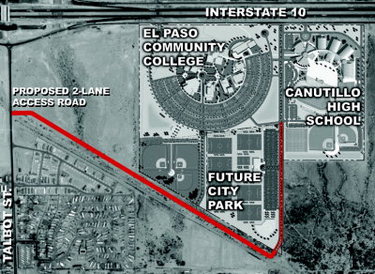
"METRO GOVERNMENT IN THE TIME OF DEFICITS"
September 10, 2009
As America endures the Great Recession, federal and state budget cuts are forcing local communities to prioritize need, optimize services, and reassess cost-sharing across governmental entities. With a $10- to 13-billion deficit facing the state of Texas next session, local communities will all need to look at doing more with less
Written by Senator Eliot Shapleigh, www.shapleigh.org
"As America endures the Great Recession, federal and state budget cuts are forcing local communities to prioritize need, optimize services, and reassess cost-sharing across governmental entities. With a $10- to 13-billion deficit facing the state of Texas next session, local communities will all need to look at doing more with less."
Increasingly, local governments are taking a close look at consolidation, whereby city and county governments merge as a single taxing entity and service provider. If done right, consolidation can do more than just help local government weather tough economic times—consolidation can revitalize government, making it more responsive to the needs of local communities, lower taxes, provide better services and meet the challenges of the 21st century.
In 1962, the city of Nashville, Tennessee and the county of Davidson consolidated all services, including the public school systems, police, fire, water and sewer services, planning and zoning, and public works. Ten years after city-county consolidation, a study showed that Nashville’s economy had improved due to diversified revenues from a larger tax base, a local sales tax, and an automobile regulatory fee. After adjusting for inflation, the tax rates in 2001 were well below what they had been in 1962.
In Nashville's final referendum election on consolidation, 57% of voters favored new, consolidated government. This support increased over time. Eight years later, 72% of citizens said that the consolidated government was as good as or better than the previous government structure.
Other examples of successful Regional Metropolitan Governments can be found in Minneapolis-St. Paul, Minnesota, and Portland, Oregon. In Minneapolis-St. Paul, the Metropolitan Council (Metro), encompasses 7 counties and provides public transportation and waste-water services, public parks and trails, and affordable housing. It also works with communities within the region to develop comprehensive planning and maintain economic growth.
In Portland, Metro serves 25 cities in three counties in the Portland region. Established by charter in 1992, the seven-member council (including a president-at-large and 6 district reps) provides planning, solid waste and recycling, finance and administrative services as well as runs the Oregon zoo, regional parks and green spaces, and the Metro Exposition Recreation Commission.
A separate study on city-county consolidation reveals that regions with consolidated governments outperformed their peers economically after consolidation. Because of a unified and larger tax base, better credit ratings, minimal in-fighting, unified plans/policies, and more dynamic leadership, consolidated governments produced more jobs and experienced a faster growth in real income. For example, from 1989 to 1999, regions with consolidated governments experienced 25% job growth, compared to 18% in non-consolidated regions. Over the same time, consolidated governments also experienced a 17% increase in capita income, compared to 11% growth in non-consolidated regions.
In El Paso, the push for city-county consolidation dates back to 1933, the same year when President Roosevelt entered office at a time when fear and panic had paralyzed the nation. It was at a time of seeing whether a representative democracy could conquer economic collapse. That year, an amendment allowing for city-county consolidation was added to the state constitution, but efforts to draft county charters for Bexar, El Paso, Tarrant, and Travis failed. In the 1980s and 1990s, El Paso appointed several commissions to explore consolidation. They concluded that, given El Paso’s unique metro area, with 80% of the population within city limits, service delivery would be more efficient with consolidation, and recommended the consolidation of tax collection, parks, some police and sheriff functions, road maintenance, data collection and GIS systems, and trash collection.
Click here to view larger image.
Click here to view larger image.
A survey conducted in March 1997 found that over half of El Pasoans supported consolidation. In 1998, El Paso joined Houston, San Antonio, and Austin, in the first-ever, multi-community meeting to discuss city-county consolidation. But consolidation efforts have since stalled.
In an effort to reduce the cost and improve the quality of local government services, I have filed legislation numerous times that would have allowed voters to decide whether to consolidate the City of El Paso and El Paso County into the El Paso Metro Government. In the 76th session, I co-authored SJR 4, a proposed constitutional amendment that would have established a process enabling consolidation. The measure passed in the Senate but failed to pass the House. It had the support of the Mayor, all members of the city council, the County Judge and a majority of the commissioners. In April 1999, an op-ed by the El Paso Times urged support for the measure:
It is unfair that El Paso's attempt to consolidate city and county governments - an effort that could save El Pasoans $1 billion over 30 years is being thwarted in the Legislature by lawmakers who live nowhere near El Paso.
In the 77th legislative session I filed SJR 13, and in the 79th legislative session, SJR 9, similar measures directed only at the El Paso region.
A recent survey by the National League of Cities showed the grimmest financial picture in 24 years. Three quarters of the 400 cities that responded said that revenue is falling at a time when expenses are rising for everything from health benefits to public safety. Only now are steep declines in housing values showing up in property tax rolls. In Dallas, the 2009 shortfall of $190 million is 10 % of the city budget, and has the City poised to lay off hundreds of employees. Ft. Worth may shut down seven city pools and force employees to take eight days of unpaid leave.
Consolidation of the City of El Paso and El Paso County into the El Paso Metro Government would allow the government to operate more efficiently by eliminating the duplication of city and county services. Some services, such as tax collections have already been consolidated. Today, the El Paso Tax Collections Office is considered to be among the most efficient tax collection operations in Texas. City-county consolidation would improve local government accountability by putting an end to finger-pointing and disputes over whom to for failures or deficiencies in public services. Finally, city-county consolidation would provide for enhanced planning capacity by creating a comprehensive planning system to deal with land development issues. Now more than ever, consolidation makes cents.

